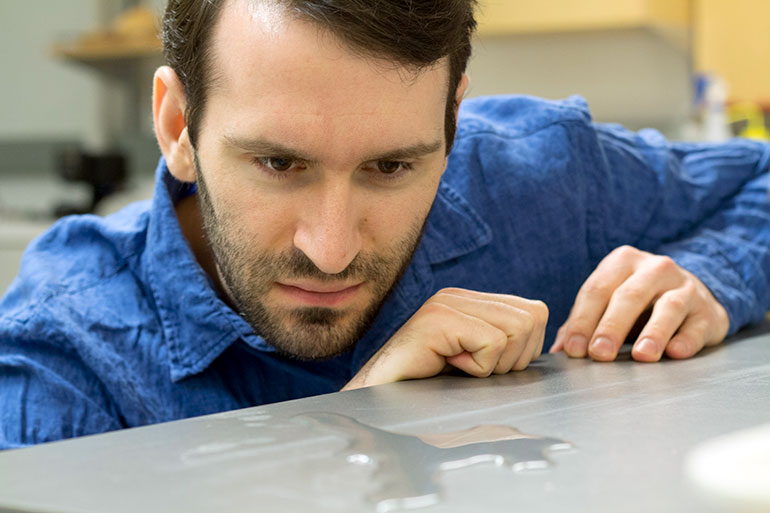
Engineering Assistant Professor Kevin Golovin observes water pooling on a superhydrophobic surface.
Superhydrophobic surfaces cut down on drag and make boats and more environmentally friendly
Boats that travel through the water, but don’t get wet. That’s the idea behind new research from UBC’s Okanagan campus that aims to make boats more efficient by creating superhydrophobic—or extremely water-repellent—surfaces.
In 2013, the Canadian marine sector emitted 5.5 megatonnes of carbon dioxide, according to Transport Canada. The vast majority of these emissions arose from burning fossil fuels to propel marine vessels.
As a result, boat manufacturers are exploring ways to limit drag by coating a ship’s hull in superhydrophobic materials.
“Superhydrophobic materials can make future marine vehicles drastically more efficient since over 60 per cent of fuel is used to overcome the friction of dragging a ship through water,” says Engineering Assistant Professor Kevin Golovin, one of the study lead authors. “In fact, we were able to create a surface that reduced that friction by over 50 per cent.”
Golovin and his team studied several different combinations of superhydrophobic surfaces in highly turbulent conditions, similar to what boats might experience when travelling through the water. The best surfaces were those that were slightly rough.
Superhydrophobic work because they contain very small holes, like divots in a golf ball. Those small pores entrap a layer of air and can significantly reduce drag, a phenomenon that Golovin says can be counterintuitive.
“Typically, it’s very smooth surfaces that have the lowest drag,” says Golovin. “Intentionally adding roughness to reduce drag is a very different approach. But the key to our study was finding the perfect balance between keeping the surface as smooth as possible while at the same time adding enough surface features to make it superhydrophobic.”
“I think we found that balance and it could be a huge benefit to future hull design.”
The study was published in the Journal of Fluid Mechanics with funding from the US Office of Naval Research.